
The most important facts in a nutshell






.webp)

Then now is the right time! Together we will turn your website into your strongest sales channel - with a clear strategy and measurable growth.
Get free adviceThe 410 error code is a means of informing clients and crawlers that the page no longer exists. In many cases, the output of the 410 status code is necessary to prevent disadvantages on the part of search engines.
What is error 410?
Error 410 appears in the browser if an already deleted URL is to be called up. The error code displayed depends on the server. It is usually labeled “Error 410” or “410 Gone.” The technical implementation of the status code also depends on the web server.
What is the 410 status code used for?
It is in the interest of search engines that new circumstances are taken into account in the index as quickly as possible. A permanently deleted subpage should definitely be declared as such. At the same time, users also have an advantage, because the 410 status code lets them know that the URL existed at an earlier point in time, and from the webmaster's point of view, this status code is not insignificant, because if the 410 status code is displayed, they know which links need to be deleted or adjusted. If the worst comes to the worst, this code can also be used to “save” links.
When should the 410 error code be set?
There are different scenarios for web projects that could make the use of the error code worthwhile.
In practice, the following applications are particularly common:
- Deletion of URLs that have been automatically created by hackers (including the so-called SEO hack).
- Deletion of URLs that have been automatically created by the CMS.
- Mass deletion when products are deleted from an online store.
- Deletion of old posts or subpages that are no longer relevant.
How do search engines interpret error 410?
The 410 error is important for the search engine crawler, as it lets it know that this URL no longer exists and no longer needs to be visited in the future. A 410 page therefore indicates that the old link should be removed from the index. If a new subpage is created with this topic, there will be no traffic competition.
How can I output the 410 error?
The error code can be integrated using different methods depending on the web server.
Apache web server
With an Apache web server, the following entry must be noted in the .htaccess file: “RewriteRule ^/category/deletedpage/ — [L, R=410] RewriteRule ^/category/deleted/ — [G] Redirect gone /deleted/” A separate error page could also be created under “Redirect gone.” To do this, the addition “ErrorDocument 410 /410-Page.html” must be added before this line.
Nginx web server
If an Nginx web server is used, the following can be entered in the nginx.conf file: “location ^/category/deleted-page/ {return 410;}” A separate error page can also be created in this case, for which the entry must be added: “error_page 410 /410-Page.html”
Difference between 410 and 404
The error code 410 is often confused with the 404 error code, as both codes indicate that the desired subpage is no longer available. However, the 404 code hardly provides any information for the crawler. In the event of a 404 error, the crawler does not necessarily remove the page from the search index immediately, which can be a disadvantage depending on the case, but there are other error codes, such as the status code 503, which is always displayed if the server cannot be reached temporarily. A subpage that can now be found under a different path should in turn be forwarded with a 302 code.
How can a 410 code be recognized?
There are various tools for detecting a 410 code. Among other things, the Chrome browser has the “Network” developer function, which can be used to read the status code.
Are you ready for rocket growth?
Arrange your personal consultation now and find out how we can help you get ahead in search engine marketing. Whether you run a small company or are responsible for a large corporation - we will find the right solution for you.


.svg)
.webp)
.webp)

.webp)





.webp)





.webp)








